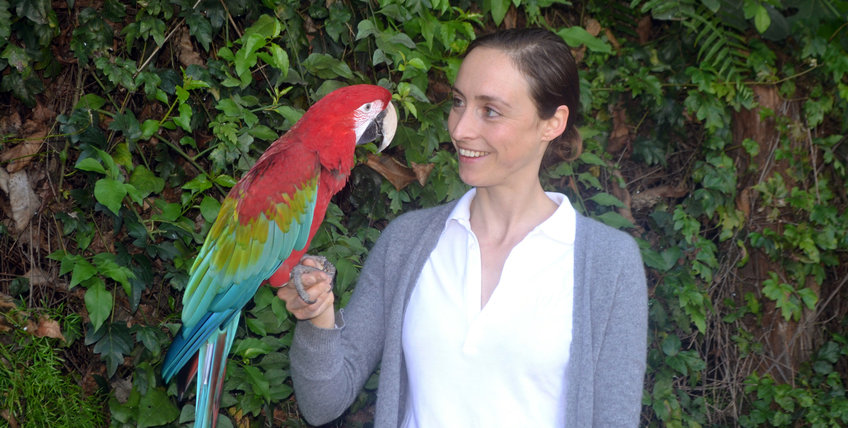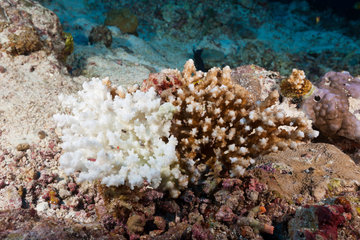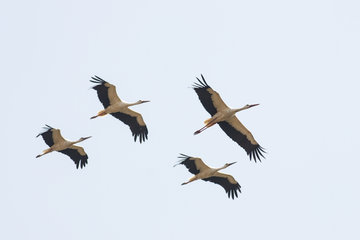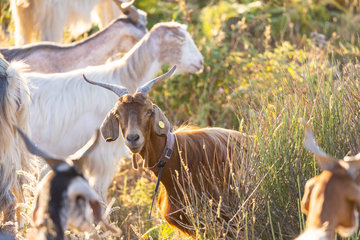"A parrot as a pet is like a toddler who never grows up"
Interview with zoologist Auguste of Bavaria on endangered parrots and their suitability as pets
“Say ‘Polly wants a cracker’!” This classic catchphrase is actually quite an insult to the birds who are among the most intelligent creatures on Earth. One particularly famous example was Harvard-based African grey parrot Alex, who not only developed a vocabulary of over 500 words, but also understood their meaning. But will these fascinating animals survive the impending species crisis? Auguste von Bayern from the Max Planck Institute for Biological Intelligence in Seewiesen is researching the cognitive abilities of various parrot species in cooperation with the Loro Parque Foundation and knows the threats and needs of the animals. Von Bayern, a champion for biodiversity conservation, is also an ambassador for "Natura 2000", a network of protected areas covering Europe's most valuable and threatened species and habitats.

What is the greatest danger for the parrots?
The biggest threat is the destruction of their habitat. This is not surprising because most species live in tropical and subtropical rainforests. And these are unfortunately particularly endangered. In Ecuador, for example, barely three percent of the primary forest remains. And only about seven percent of the Brazilian rainforest along the east coast, the Mata Atlantica, remains. Parrots cannot survive without these forests. That’s because many species are cavity breeders and depend on specific species of large old trees. They also often feed on highly specific fruits and nuts.
Another big problem is the pet trade. For example, a chick of a great green macaw (Ara ambiguus) is traded on the black market for around 900 euros; an adult bird bred in captivity costs around 1500 euros. Endangered parrot species are even hunted for their feathers or simply for sport. I also recently found out that the great green macaw I am researching is still eaten in Panama because of ignorance and a lack of meat.
Which species are particularly under threat?
The Brazilian Spix’s macaw (Cyanopsitta spixii) – made famous by the animated film “Rio” – is particularly threatened and is now extinct in the wild. Also the New Caledonian lorikeet (Charmosyna diadema), the Brazilian grey-breasted parakeet (Pyrrhura griseipectus), and the New Zealand kakapo (Strigops habroptilus). Of the 387 parrot species known today, almost one third (109) are on the Red List. Of these, 17 are “threatened with extinction” and 38 are “endangered”. There are also 16 species that we know have become extinct in the last few centuries. This makes the birds a particularly threatened group of animals.
Parrots are thus ambassadors for a biodiversity crisis of historic proportions. The human-caused extinction rate is 100- to 1000-fold greater than the normal biological rate. This is the largest mass extinction since the extinction of the dinosaurs 66 million years ago. The Intergovernmental Science-Policy Platform on Biodiversity and Ecosystem Services warns of the drastic extent and speaks of one million species acutely threatened with extinction. However, the actual figure is probably considerably higher because we are far from knowing all the species. In Germany, too, animals and plants are being lost on an unimaginable scale. More than half of the 259 permanently breeding bird species here are endangered. Fourteen species are extinct in Germany so far. And six more will most likely have to be listed in the next Red List as no longer occurring.
However, parrots are also figureheads for species and habitat conservation. That’s because many equally threatened but more inconspicuous or less charismatic species benefit from their protection. Their populations also respond well to conservation measures. Examples of successful species conservation are the grey-breasted parakeet, the kakapo, and Lear’s macaw (Anodorhynchus leari) as well as the reintroduction of the great green macaw.
Which organisations care about the conservation of parrots?

Birdlife International, the World Parrot Trust, Parrots International, and ZGAP – to name but a few. The Loro Parque Foundation, which I collaborate with, is also highly committed to parrot conservation. The foundation supports conservation projects for 30 to 40 parrot species (as well as some marine mammals) with the aim of saving endangered species from extinction. Thanks to their commitment, nine parrot species were saved from extinction. Five of them were even downgraded in their threat status. An important aspect of the foundation’s work is responsible breeding in order to curb illegal trade as well as offspring breeding for gene conservation and the reintroduction of endangered species. For this reason, it maintains a breeding station on Tenerife, where more than 4,500 animals from over 200 species live.
Which aspects of the parrots do you explore?
My working group is using birds to better understand the evolution of intelligence and complex communication within vertebrates and to find out how language is related to intelligence. Very little research has been done on parrots so far. Together with the crow family, they have the largest brain relative to the body of all vertebrates – along with primates and dolphins. But they have a much higher density of nerve cells. Parrots are also unique with respect to their highly developed cognitive abilities and complex social life. This species-rich and diverse group of birds inhabits a wide variety of habitats – from dry savannah to the deepest rainforest to mountainous regions. They are therefore particularly suitable for a systematic comparison between species.
And as we all know, parrots can learn and imitate sounds with considerable ease. They could therefore be a key to understanding the evolution of human language. That’s because vocal learning and imitation is also a basic requirement of human language and occurs in only a few animal groups. In the breeding facility of the Loro Parque Foundation, we can systematically compare the cognitive abilities of different parrot species and thus find out which factors influence the intelligence and imitation ability of the animals and which might also have played a role in human evolution.
In the process, we also carry out important educational work. In our research station, which is integrated into Loro Parque Zoo, we work with three endangered macaw species and two other threatened species. In our mirrored “laboratory”, we conduct behavioural tests in front of approximately 1.4 million zoo visitors each year without the parrots and researchers themselves noticing. In doing so, we introduce people to the fascinating cognitive abilities of these charismatic birds. You can literally see how the animals weigh up their decisions according to costs and benefits and spontaneously help or imitate conspecifics. You can also see whether they can plan for the future and solve complex thinking tasks.
I am sure that the realisation that these animals rank on the same intelligence level as apes will give people food for thought and stir their conscience. After all, we cannot allow such highly intelligent and fascinating animals to become extinct.
How should parrots be kept? What is the minimum requirement?
Parrots should really be kept only by experts. Through their international breeding programmes and educational work, zoos and professional breeders such as the Loro Parque Foundation fulfil important – and unfortunately now indispensable – functions for species conservation. Parrots serve as ambassadors for their threatened conspecifics in the wild and thus help underline importance of species conservation.
Many parrot species are unsuitable as pets. They are demanding and often extremely, if not unbearably, loud. They easily develop quirks and behavioural abnormalities such as feather plucking or incessant crying if they cannot live out their natural behaviour and their urge to move and nibble or if they receive too little attention.
Parrots need a lot of space and should not be kept alone. They are highly social animals, and most species partner for life. An aviary cannot be big enough. A cage or keeping a parrot on a pole with a chain around the leg – as it is still often found today – is absolutely out of the question and should be prohibited. The right temperature and humidity as well as adequate food are also important. Otherwise, the birds will become susceptible to disease and die. Keeping parrots can be costly. You should therefore consider beforehand whether you can permanently meet these demands. After all, some species can live extremely long lives.
In any case, you should be aware that parrots are animals that are cognitively on the same level as chimpanzees or gorillas. You are dealing with a toddler, so to speak. But one that never grows up and which is many times louder.













